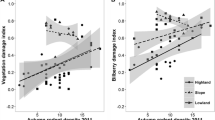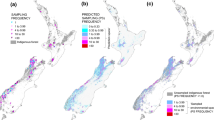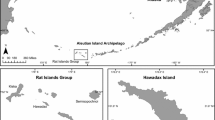Abstract
For effective and efficient pest management it is essential to understand the ecology of the target species and recipient ecosystems. The use of rodent eradication as a restoration tool is well established in temperate regions, but less common in the tropics, presenting an opportunity to undertake scientific learning in tandem with rodent eradications. On a dry tropical archipelago, we used a Before-After-Control-Impact framework to document (1) fluctuations in the abundance and demography of invasive Rattus rattus and Mus musculus on three different islands, (2) the trophic niche of all three invasive rodent populations, and (3) changes in the invertebrate community before and after rodent eradication, also comparing with two rodent free islands. While rat density was high and relatively stable throughout the year, the two mouse populations greatly differed in body size and seasonal dynamics, despite their proximity. The rodents in all three populations were generalist and opportunistic feeders, although stable isotope analyses results indicated major differences among them, driven by food availability and rodent species. Seasonal fluctuations in invertebrate communities depended on rodent invasion status, but recovery in the invertebrate communities one year after rodent removal was limited for all islands. Predictions for other tropical ecosystem biomes require long-term research on more tropical islands. Improving our understanding of island and species-specific contexts of rodent eradications can advance island restoration projects and assist the selection of indicator species for ecosystem recovery.







Similar content being viewed by others
References
Adler GH (1996) The island syndrome in isolated populations of a tropical forest rodent. Oecologia 108:694–700. doi:10.1007/bf00329044
Adler GH (1998) Impacts of resource abundance on populations of a tropical forest rodent. Ecology 79:242–254. doi:10.2307/176879
Adler GH, Levins R (1994) The island syndrome in rodent populations. Q Rev Biol 69:473–490. doi:10.1086/418744
Adler GH, Tomblin DC, Lambert TD (1998) Ecology of two species of echimyid rodents (Hoplomys gymnurus and Proechimys semispinosus) in central Panama. J Trop Ecol 14:711–717. doi:10.1017/s0266467498000509
Angel A, Wanless RM, Cooper J (2008) Review of impacts of the introduced house mouse on islands in the Southern Ocean: are mice equivalent to rats? Biol Invasions 11:1743–1754. doi:10.1007/s10530-008-9401-4
Arneson LS, MacAvoy SE (2005) Carbon, nitrogen, and sulfur diet-tissue discrimination in mouse tissues. Can J Zool 83:989–995. doi:10.1139/z05-083
Atkinson IAE (1985) The spread of commensal species of Rattus to oceanic islands and their effect on island avifaunas. In: Moors PJ (ed) Conservation of island birds. International Council for Bird Preservation, Cambridge, pp 35–81
Atkinson IAE (1989) Introduced animals and extinctions. In: Western D, Pearl MC (eds) Conservation for the twenty-first century. Oxford University Press, New York, pp 54–75
Bearhop S, Adams CE, Waldron S, Fuller RA, Macleod H (2004) Determining trophic niche width: a novel approach using stable isotope analysis. J Anim Ecol 73:1007–1012. doi:10.1111/j.0021-8790.2004.00861.x
Bonet F, Rzedowski J (1962) La vegetación de las islas del Arrecife Alacranes, Yucatán, México. Anales de la Escuela Nacional de Ciencias Biológicas 11:15–59
Broome KG, Fairweather AAC, Fisher P (2012) Brodifacoum Pesticide Information Review. Version 2012/1. Unpublished report docdm-25439. Department of Conservation, Hamilton, NZ
Burggren WW, McMahon BR (1988) Biology of the land crabs. Cambridge University Press, Cambridge. doi:10.1017/s0025315400049249
Caut S, Casanovas JG, Virgos E, Lozano J, Witmer GW, Courchamp F (2007) Rats dying for mice: modelling the competitor release effect. Austral Ecol 32:858–868. doi:10.1111/j.1442-9993.2007.01770.x
Caut S, Angulo E, Courchamp F (2008a) Avoiding surprise effects on Surprise Island: alien species control in a multitrophic level perspective. Biol Invasions 11:1689–1703. doi:10.1007/s10530-008-9397-9
Caut S, Angulo E, Courchamp F (2008b) Dietary shift of an invasive predator: rats, seabirds and sea turtles. J Appl Ecol 45(2):428–437. doi:10.1111/j.1365-2664.2007.01438.x
Choquenot D, Parkes J (2001) Setting thresholds for pest control: how does pest density affect resource viability? Biol Conserv 99:29–46. doi:10.1016/s0006-3207(00)00186-5
CONANP (2006) Programa de Conservación y Manejo Parque Nacional Arrecife Alacranes. SEMARNAT, México
Costello MJ, May RM, Stork NE (2013) Can we name earth’s species before they go extinct? Science 339:413–416. doi:10.1126/science.1230318
Efford MG, Fitzgerald BM, Karl BJ, Berben PH (2006) Population dynamics of the ship rat Rattus rattus L. in the Orongorongo Valley, New Zealand. N Z J Zool 33:273–297. doi:10.1080/03014223.2006.9518457
Fosberg FR (1962) A brief study of the cays of Arrecife Alacran, a Mexican atoll. Atoll Res Bull 93:1–33. doi:10.5479/si.00775630.93.1
García EA (1988) Modificaciones al sistema de clasificación climática de Köppen. UNAM, México
Gibbs GW (2009) The end of an 80-million year experiment: a review of evidence describing the impact of introduced rodents on New Zealand’s ‘mammal-free’ invertebrate fauna. Biol Invasions 11:1587–1593. doi:10.1007/s10530-008-9408-x
Goldwater N, Perry GLW, Clout MN (2012) Responses of house mice to the removal of mammalian predators and competitors. Austral Ecol 37:971–979. doi:10.1111/j.1442-9993.2011.02356.x
Green C (2000) Pitfall trapping for long term monitoring of invertebrates. Ecol Manag 8:73–93
Harper GA (2007) Detecting predation of a burrow-nesting seabird by two introduced predators, using stable isotopes, dietary analysis and experimental removals. Wildl Res 34:443–453. doi:10.1071/wr0703710.2307/3677011
Harper GA, Rutherford M (2016) Home range and population density of black rats (Rattus rattus) on a seabird island: a case for a marine subsidised effect? N Z J Ecol 40: 219–228. doi:10.20417/nzjecol.40.25
Harper GA, van Dinther M, Russell JC, Bunbury N (2015) The response of black rats (Rattus rattus) to evergreen and seasonally arid habitats: informing eradication planning on a tropical island. Biol Conserv 185:66–74. doi:10.1016/j.biocon.2014.11.044
Harris DB, Macdonald DW (2007a) Interference competition between introduced black rats and endemic Galápagos rice rats. Ecology 88:2330–2344. doi:10.1890/06-1701.1
Harris DB, Macdonald DW (2007b) Population ecology of the endemic rodent Nesoryzomys swarthi in the tropical desert of the Galápagos islands. J Mammal 88:208–219. doi:10.1644/05-mamm-a-370r4.1
Hoare JM, Hare KM (2006) The impact of brodifacoum on non-target wildlife: gaps in knowledge. N Z J Ecol. doi:10.1080/03014223.1995.9518055
Holmes ND, Griffiths R, Pott M, Alifano A, Will D, Wegmann AS, Russell JC (2015) Factors associated with rodent eradication failure. Biol Conserv 185:8–16. doi:10.1016/j.biocon.2014.12.018
Howell SNG (1989) Additional information on the Birds of the Campeche Bank, Mexico. J Field Ornithol 60(4):504–509
Hutchinson GE (1978) An introduction to population ecology. Yale University Press, New Haven
Jones HP, Tershy BR, Zavaleta ES, Croll DA, Keitt BS, Finkelstein ME, Howald GR (2008) Severity of the effects of invasive rats on seabirds: a global review. Conserv Biol 22:16–26. doi:10.1111/j.1523-1739.2007.00859.x
Keitt B et al (2015) Best practice guidelines for rat eradication on tropical islands. Biol Conserv 185:17–26. doi:10.1016/j.biocon.2014.10.014
Kurle CM (2009) Interpreting temporal variation in omnivore foraging ecology via stable isotope modelling. Funct Ecol 23:733–744. doi:10.1111/j.1365-2435.2009.01553.x
Kurle CM, Croll DA, Tershy BR (2008) Introduced rats indirectly change marine rocky intertidal communities from algae-to invertebrate-dominated. Proc Natl Acad Sci USA 105:3800–3804. doi:10.1073/pnas.0800570105
Kurle CM, Koch PL, Tershy BR, Croll DA (2014) The effects of sex, tissue type, and dietary components on stable isotope discrimination factors (d13C and d15 N) in mammalian omnivores. Isot Environ Health Stud 50:307–321. doi:10.1080/10256016.2014.908872
Lowe S, Browne M, Boudjelas S, De Poorter M (2000) 100 of the world’s worst invasive alien species. ISSG, SSC, IUCN, Auckland
Mittermeier RA, Turner WR, Larsen FW, Brooks TM, Gascon C (2011) Global biodiversity conservation: the critical role of hotspots. In: Zachos FE, Habel JC (eds) Biodiversity hotspots. Springer, Berlin, pp 3–22. doi:10.1007/978-3-642-20992-5_1
Mulder CPH et al (2009) Direct and indirect effects of rats: does rat eradication restore ecosystem functioning of New Zealand seabird islands? Biol Invasions 11:1671–1688. doi:10.1007/s10530-008-9396-x
Mulder CPH, Anderson WB, Towns DR, Bellingham PJ (eds) (2011) Seabird islands: ecology, invasion, and restoration. Oxford University Press, New York. doi:10.1093/acprof:osobl/9780199735693.001.0001
Newsome SD, Martinez del Rio C, Bearhop S, Phillips DL (2007) A niche for isotopic ecology. Front Ecol Environ 5:429–436. doi:10.1890/060150.1
Osborne PL (2000) Tropical ecosystems and ecological concepts. Cambridge University Press, Cambridge
PNAA-Parque Nacional Arrecife Alacranes (2011) Conservación y protección de la tortuga verde (Chelonia mydas) en el Parque Nacional Arrecife Alacranes. http://www.conanp.gob.mx/acciones/fichas/tortuverde/tortu_verde.pdf
R Core Team (2013) R: A language and environment for statistical computing. R Foundation for Statistical Computing. http://www.R-project.org/. Accessed 1 Feb 2013
Ringler D, Russell J, Jaeger A, Pinet P, Bastien M, Le Corre M (2014) Invasive rat space use on tropical islands: implications for bait broadcast. Basic Appl Ecol 15:179–186. doi:10.1016/j.baae.2014.01.005
Rodríguez MMA, Herrera MLG (2013) Isotopic niche mirrors trophic niche in a vertebrate island invader. Oecologia 171:537–544. doi:10.1007/s00442-012-2423-8
Ruffino L, Russell JC, Pisanu B, Caut S, Vidal E (2011) Low individual-level dietary plasticity in an island-invasive generalist forager. Popul Ecol 53:535–548. doi:10.1007/s10144-011-0265-6
Ruffino L, Zarzoso-Lacoste D, Vidal E (2015a) Assessment of invasive rodent impacts on island avifauna: methods, limitations and the way forward. Wildl Res 42:185–195. doi:10.1071/WR15047
Ruffino L et al (2015b) Eradications as scientific experiments: progress in simultaneous eradications of two major invasive taxa from a Mediterranean island. Pest Manage Sci 71:189–198. doi:10.1002/ps.3786
Ruscoe WA, Murphy EC (2005) House mouse. In: King CM (ed) The handbook of New Zealand mammals, 2nd edn. Oxford University Press, Melbourne, pp 204–221
Russell JC, Holmes ND (2015) Tropical island conservation: rat eradication for species recovery. Biol Conserv 185:1–7. doi:10.1016/j.biocon.2015.01.009
Russell JC, Ringler D, Trombini A, Corre M (2011) The island syndrome and population dynamics of introduced rats. Oecologia 167:667–676. doi:10.1007/s00442-011-2031-z
Russell JC, Caut S, Anderson SH, Lee M (2015) Invasive rat interactions and over-invasion on a coral atoll. Biol Conserv 185:59–65. doi:10.1016/j.biocon.2014.10.001
Russell JC, Binnie HR, Oh J, Anderson D, Samaniego-Herrera A (2017) Optimizing confirmation of invasive species eradication with rapid eradication assessment. J Appl Ecol 54:160–169. doi:10.1111/1365-2664.12753
Samaniego-Herrera A, Bedolla-Guzmán Y (2012) Land crabs (Decapoda, Brachyura, Gecarcinidae) on Isabel Island, Mexico, including a new record, and its relation to the removal of invasive rats. Crustaceana 85:1007–1011. doi:10.2307/23240244
Samaniego-Herrera A, Anderson DP, Parkes JP, Aguirre-Muñoz A (2013) Rapid assessment of rat eradication after aerial baiting. J Appl Ecol 50:1415–1421. doi:10.1111/1365-2664.12147
Samaniego-Herrera A, Russell JC, Choquenot D, Aguirre-Muñoz A, Clout M (2014) Invasive rodents on tropical islands: Eradication recommendations from Mexico. In: Timm RM, O’Brien JM (eds) Proc. 26th Vertebr. Pest Conf., Kona, Hawaii, 2014. University of California, Davis, pp 43–50
Samaniego-Herrera A, Aguirre-Muñoz A, Bedolla-Guzmán Y, Cárdenas-Tapia A, Félix-Lizárraga M, Méndez-Sánchez F, Reina-Ponce O, Rojas-Mayoral E, Torres-García F (2017) Eradicating invasive rodents from wet and dry tropical islands in Mexico. Oryx. doi:10.1017/S0030605316001150
Schwarz CJ (2013) Analysis of BACI experiments. In: Course notes for beginning and intermediate statistics. Simon Fraser University. http://people.stat.sfu.ca/~cschwarz/CourseNotes/. Accessed June 2013
Shiels AB, Flores CA, Khamsing A, Krushelnycky PD, Mosher SM, Drake DR (2013) Dietary niche differentiation among three species of invasive rodents (Rattus rattus, R. exulans, Mus musculus). Biol Invasions 15:1037–1048. doi:10.1007/s10530-012-0348-0
Shiels AB, William CP, Sugihara RT, Witmer GW (2014) Biology and impacts of Pacific island invasive species. The black rat, Rattus rattus (Rodentia, Muridae). Pac Sci 68:145–184. doi:10.2984/68.2.1
Sinclair L, McCartney J, Godfrey J, Pledger S, Wakelin M, Sherley G (2005) How did invertebrates respond to eradication of rats from Kapiti Island, New Zealand? N Z J Zool 32:293–315. doi:10.1080/03014223.2005.9518421
Singleton GR, Krebs CJ (2007) The secret world of wild mice. In: Fox JG, Davisson MT, Quimby FW, Barthold SW, Newcomer CE, Smith AL (eds) The mouse in biomedical research, 2nd edn. Academic Press, Burlington, pp 25–51. doi:10.1016/B978-012369454-6/50015-7
St Clair JJH (2011) The impacts of invasive rodents on island invertebrates. Biol Conserv 144:68–81. doi:10.1016/j.biocon.2010.10.006
St Clair JJ, Poncet S, Sheehan DK, Székely T, Hilton GM (2011) Responses of an island endemic invertebrate to rodent invasion and eradication. Anim Conserv 14(1):66–73. doi:10.1111/j.1469-1795.2010.00391.x
Stork NE, Blackburn TM (1993) Abundance, body size and biomass of arthropods in tropical forest. Oikos 67:483–489. doi:10.2307/3545360
Stork NE, Habel JC (2014) Can biodiversity hotspots protect more than tropical forest plants and vertebrates? J Biogeogr 41:421–428. doi:10.1111/jbi.12223
Tieszen LL, Boutton TW, Tesdahl K, Slade NA (1983) Fractionation and turnover of stable carbon isotopes in animal tissues: implications for δ13C analysis of diet. Oecologia 57:32–37. doi:10.1007/bf00379558
Towns DR (2009) Eradications as reverse invasions: lessons from Pacific rat (Rattus exulans) removals on New Zealand islands. Biol Invasions 11:1719–1733. doi:10.1007/s10530-008-9399-7
Towns DR, Atkinson IAE, Daugherty CH (2006) Have the harmful effects of introduced rats on islands been exaggerated? Biol Invasions 8:863–891. doi:10.1007/s10530-005-0421-z
Towns DR et al (2009) Predation of seabirds by invasive rats: multiple indirect consequences for invertebrate communities. Oikos 118:420–430. doi:10.1111/j.1600-0706.2008.17186.x
Towns, Byrd GV, Jones HP, Rauzon MJ, Rusell JC, Wilcox C (2011) Impacts of introduced predators on seabirds. In: Mulder CPH, Anderson WB, Towns, Bellingham PJ (eds) Seabird islands: ecology, invasion, and restoration. Oxford University Press, New York, pp 56–90. doi:10.1093/acprof:osobl/9780199735693.003.0003
Tunnell JW, Chapman BR (2000) Seabirds of the Campeche Bank Islands, Southeastern Gulf of Mexico. Atoll Res Bull 481–493:41–50. doi:10.5479/si.00775630.482.1
Weisser WW, Siemann E (eds) (2004) Insects and ecosystem function, vol 173, 1st edn. Springer, New York. doi:10.1007/978-3-540-74004-9
Yeakel JD, Bhat U, Elliott Smith ES, Newsome SD (2016) Exploring the isotopic niche: isotopic variance, physiological incorporation, and the temporal dynamics of foraging. Front Ecol Evol. doi:10.3389/fevo.2016.00001
Zavaleta ES, Hobbs RJ, Mooney HA (2001) Viewing invasive species removal in a whole-ecosystem context. Trends Ecol Evol 16(8):454–459. doi:10.1016/s0169-5347(01)02194-2
Acknowledgements
We dedicate this work to Dave Choquenot (1959–2015), who made major contributions to the conservation of the Mexican islands. The research and management projects are part of the National Island Restoration Program in which all of our colleagues at Grupo de Ecología y Conservación de Islas (GECI) in Mexico are actively involved. This program is funded thanks to collaborative efforts, both at the national and international level. Identification of invertebrates was kindly conducted by entomologist Griselda Montiel Parra (Instituto de Biología, UNAM, Mexico). We thank the island residents for their support and collaboration and Dr. Nuno Simoes (UNAM-UMDI) for all the help, equipment and contacts provided. All the volunteer students were exceptionally helpful. A.S.-H. thanks CONACYT for the doctoral scholarship and WWF for the EFN fellowship. We thank two anonymous reviewers for improving the manuscript.
Funding
Principal funding sources for the Arrecife Alacranes project were U.S. Fish and Wildlife Service, National Fish and Wildlife Foundation and Packard Foundation. The National Commission of Natural Protected Areas (CONANP) and the Mexican Navy (SEMAR) provided valuable in-kind support which solved much of the logistics. The University of Auckland funded the stable isotope analysis. To all institutions we are most grateful for their sustained support.
Author contributions
A.S-H. designed and performed research and wrote the paper as PhD student; A.S-H. and J.R undertook statistical analyses. M.C., J.R. and A.A-M. supervised the research.
Author information
Authors and Affiliations
Corresponding author
Rights and permissions
About this article
Cite this article
Samaniego-Herrera, A., Clout, M.N., Aguirre-Muñoz, A. et al. Rodent eradications as ecosystem experiments: a case study from the Mexican tropics. Biol Invasions 19, 1761–1779 (2017). https://doi.org/10.1007/s10530-017-1388-2
Received:
Accepted:
Published:
Issue Date:
DOI: https://doi.org/10.1007/s10530-017-1388-2




